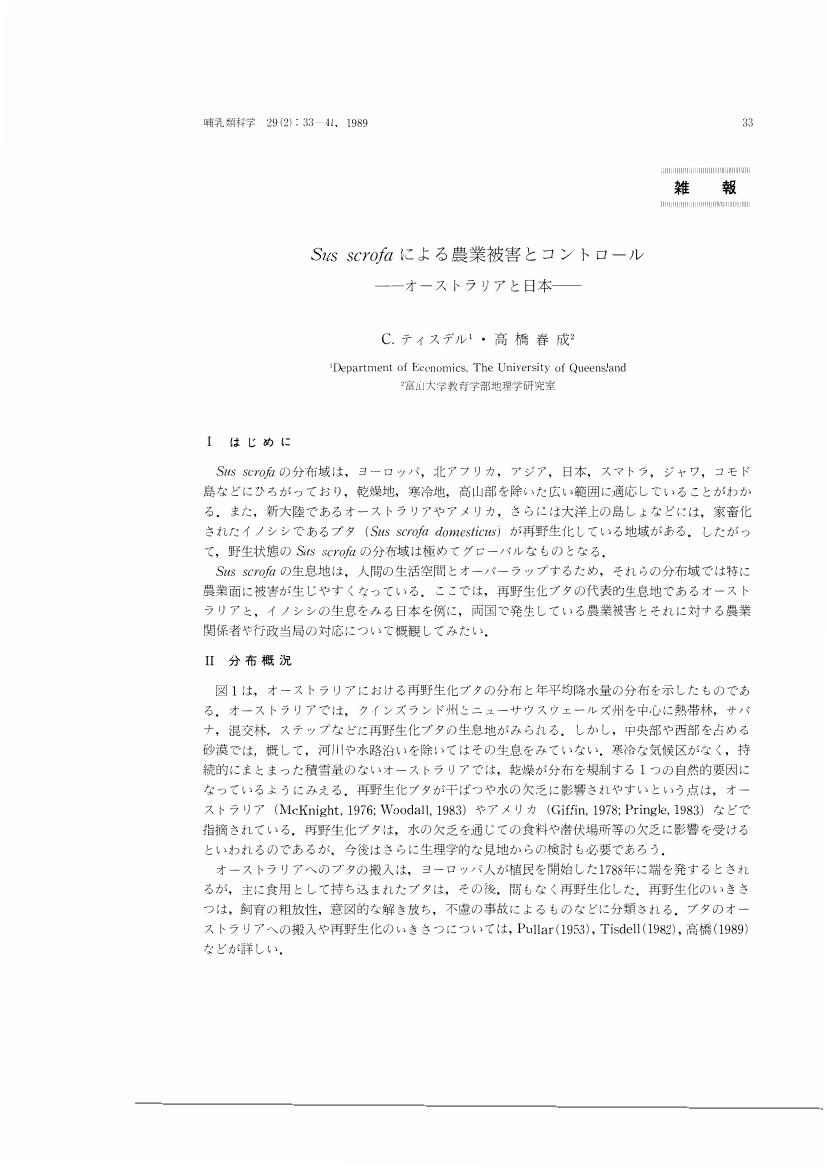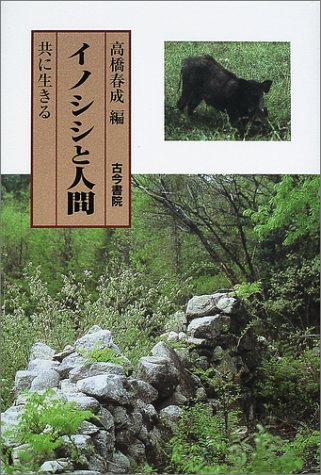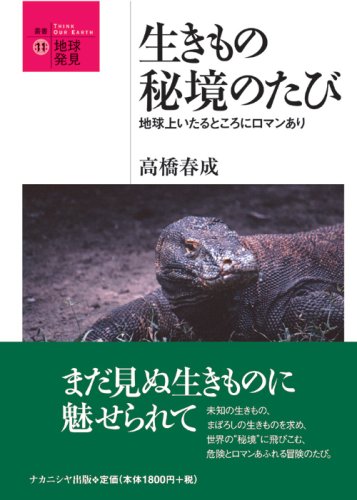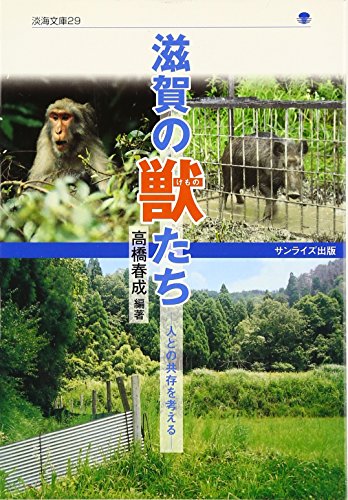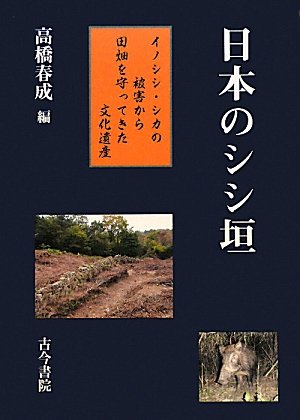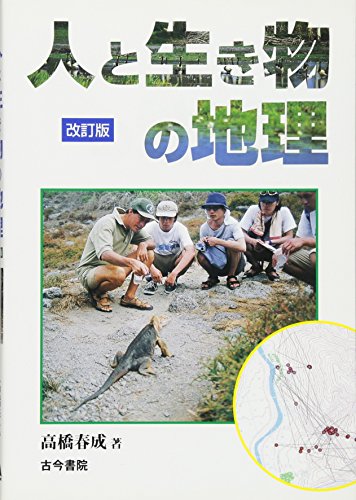6 0 0 0 IR 地域遺産としてのシシ垣遺構
- 著者
- 高橋 春成
- 出版者
- 奈良大学総合研究所
- 雑誌
- 総合研究所所報 (ISSN:09192999)
- 巻号頁・発行日
- no.18, pp.87-99, 2010
シシ垣は、漢字で「猪垣」、「鹿垣」、「猪鹿垣」と書く。遺構といえば、これまで貴族や豪族、武士などの遺構1が注目され、農民の遺構であるシシ垣の多くは等閑視されてきた。平成17年施行の文化財保護i法の一部改正により、「文化的景観」が新たに文化財に位置づけられ、シシ垣も「農林水産業に関連する文化的景観」として注目されるようになったことは意義深い。これを機に、今後さらに、全国のシシ垣のデータベース作り、シシ垣の文化財指定、シシ垣の保存と有効活用についての取り組みを推進する必要がある。
5 0 0 0 OA 西表島の再野生化・半再野生化動物
- 著者
- 高橋 春成 ティズデル C.A.
- 出版者
- The Association of Japanese Geographers
- 雑誌
- Geographical review of Japan, Series B (ISSN:02896001)
- 巻号頁・発行日
- vol.65, no.1, pp.66-72, 1992-06-30 (Released:2008-12-25)
- 参考文献数
- 12
- 被引用文献数
- 2 3
わが国には再野生化または半再野生化動物はまれであるが,西表島には再野生化あるいは半再野生化したブタ(イノブタを含む),ヤギ,ウシが生息している。 ブタについては,これまでにも在来のブタの離脱とそれらとリュウキュウイノシシの混血が指摘されてきた。近年でも,内離島や外離島でイノブタ(リュウキュウイノシシ×ランドレース)が再野生化状態にあり,一部は本島に侵入している。また,本島でもイノブタの離脱が生じた。近年のイノブタの離脱の要因は,粗放的な飼育方法や管理の不行届きに求められる。これらのイノブタもまた,リュウキュウイノシシと混血しているものと推測される。西表島で,再野生化したブタの集団が形成されないのは,在来のイノシシ集団に何らかのかたちで吸収されているためと考えられる。ブタやイノブタの離脱によるリュウキュウイノシシとの混血は,リュウキュウイノシシの遺伝子を撹乱するため,在来動物の保護の点から問題がある。 ヤギとウシの場合は,同島にそれらの原種が生息しないため,混血や原種集団へのとけこみが生じることがない。現在みられるヤギの再野生化は,近年の森林伐採作業用キャンプ地の撤去に伴なう遺棄や台風による小屋の破損などのために生じた。近年,ウシもまた一部が内離島,外離島,本島西部で再野生化状態となっている。これらは,管理の不行届きが原因である。当地では,再野生化したヤギやウシによる在来の植生への影響が生じているものと推測される。 西表島では,行政当局によるこれらのイノブタ,ヤギ,ウシに対する関心は高くない。それは,これらの頭数が多くないこと,在来の動植物への被害状況が不鮮明であること,農業被害がほとんどみられないことなどによる。しかし,西表島は大部分が国立公園に指定されていることから,特に在来の生態系への影響に注意する必要がある。
3 0 0 0 IR 南西諸島の海を泳ぐイノシシ
- 著者
- 高橋 春成
- 出版者
- 奈良大学総合研究所
- 雑誌
- 総合研究所所報 (ISSN:09192999)
- 巻号頁・発行日
- no.23, pp.1-12, 2015
近年、我国ではイノシシの分布拡大が顕著である。その中で、イノシシが海を泳いで周辺の島々に渡っている事例もみられる。今回は、そのような地域の一つである南西諸島において実態調査を行った。その結果、奄美群島では、主として海岸部で行われる猟犬を使った狩猟圧や駆除圧によって在来のリュウキュウイノシシが周辺の島に渡っていることが明らかになった。今後はさらに、食料獲得など生態的な要因に関する調査も必要である。一方、慶良間列島では、持ち込まれたニホンイノシシが野生化し、周辺の島に侵入している実態が明らかになった。当地は、ラムサール条約湿地として登録され、国立公園にも指定されている。アオウミガメの産卵地、ベニアジサシやコアジサシなどの海鳥の繁殖地があり、侵入したニホンイノシシによる卵や孵化した子などの食害、営巣の妨害などが懸念され、今後の早急な対応が求められる。
1 0 0 0 再野生化ブタの分布と発生過程
- 著者
- 高橋 春成
- 出版者
- 公益社団法人 日本地理学会
- 雑誌
- 地理学評論 Ser. A (ISSN:00167444)
- 巻号頁・発行日
- vol.62, no.7, pp.513-537, 1989
- 被引用文献数
- 3
The feralization of livestock is one of the themes of geography, but few studies have been done aside from those of T. L. McKnight. The author studied feral pigs, with particularr emphasis on distribution, time of the feralization, background of feralization, and attitudes toward feral pigs, through analysis of reference works in geography and other academic fields and investigation in Australia and the Ogasawara Islands in Japan.<br> The author examined the distribution of feral pigs in comparison with that of Eurasian wild boars (from which pigs are domesticated). The distinction between feral pigs and Eurasian wild boars is not always clear, however. Domestic pigs roamed and had opportunities to become wild under traditional husbandry practices such as free ranging and mast feeding in Europe and Asia, and they are mostly regarded to have merged with Eurasian wild boars. Further, introduced Eurasian wild boars interbred with feral pigs in the United States, the Republic of South Africa, and parts of South America. Almost everywhere there is evidence of human modification of the indigenous fauna.<br> Regarding the time of feralization, the author examined data from North and South America, Australia, and some islands where the time was comparatively clear. According to this analysis, pigs were introduced to some islands in the Pacific Ocean by Melanesians and Polynesians, and feralization occurred even though their distribution was limited. From the 15th century to the 19th century, explorers, colonists, sealers, and whalers introduced or released pigs on many oceanic islands and new continents. In this period, pig feralization occurred frequently, and the main feral pig's areas were established. Deliberate release by landholders and hunters continues in some areas even today.<br> Extensive husbandry, deliberate release, and accidental escape are important factors in feralization. The spread of practices such as free ranging and mast, feeding contributed to pig feralization. Deliberate release by explorers, fishermen, landholders, and hunters is also a major factor. In these cases, we can point out the influence of humans who recognize the value of feral pigs as sources of food or game.<br> Regarding attitudes toward feral pigs, the author examined data from Australia and the United States. In general, feral livestock including feral pigs were useful to pioneers and early settlers as supplementary animals. But as time passed, feral pigs came to be legally classified as noxious or verminous in Australia because of the damage they caused wheat farmers and raisers of sheep and cattle. In the United States, where such severe damage did not occur, feral pigs are legally classified as game. However, in both countries there are conflicts of interest among farmers, hunters, and landholders who collect hunting fees; all these groups have different attitudes toward feral pigs, which make it difficult to control feral pigs effectively.<br> In the Ogasawara Islands, feral pigs were recorded as early as Commodore Perry's expedition in 1853. But it is difficult to collect clear evidence of these feral pigs today. In the period in which the islands under occupation by the U. S. Navy after World War II, pigs were brought from Tinian Island by the Navy, and a number of them were released. It is said that pigs were released for food supply and game on Ototo Island and Chichi Island, as a future source of food of fishermen on Muko Island and Nakodo Island. Their descendants are thought to have survived on Ototo Island.
- 著者
- ティスデル C. 高橋 春成
- 出版者
- 日本哺乳類学会
- 雑誌
- 哺乳類科学 (ISSN:0385437X)
- 巻号頁・発行日
- vol.29, no.2, pp.33-41, 1989
1 0 0 0 OA 野生化家畜の文化地理学的研究
- 著者
- 高橋 春成
- 出版者
- The Human Geographical Society of Japan
- 雑誌
- 人文地理 (ISSN:00187216)
- 巻号頁・発行日
- vol.48, no.4, pp.364-377, 1996-08-28 (Released:2009-04-28)
- 参考文献数
- 105
- 被引用文献数
- 1 1
The author made a review of feral animals in Australia, from a cultural-geographic viewpoint.European people went on voyages to find new colonies from the 15th to the 19th centuries. They had a custom of keeping livestock on board ship as food provisions. Consequently pigs, goats, cattle, horses and donkeys, etc. were introduced to new colonies a long with traditional European ways of keeping and releasing livestock.It was a common practice in the early days of settlement to let livestock roam or have free range so as to forage for food. In the 19th century, sealers and whalers released livestock such as pigs and goats on islands as food. As a result, some of these animals formed viable breeding colonies in the wild. Feral livestock populations established quickly and they were widely spread in Australia before the beginning of this century.However, the spread of feral animals like feral pigs, goats, horses, cattle, donkeys, water buffaloes and camels etc. caused changes in the biological environment. The majority of native Australian land mammals are marsupials. The intrusion of these exotic species appears to be altering the composition of species in Australia and is causing significant ecological and environmental change.Today feral animals are generally considered to be pests, because these animals damage agriculture and the native fauna and flora. However some discussion is necessary as follows:1) Feral animals are a‘product’of human culture.2) In case we consider feral animals as one example of environmental problems, we should not criticize traditional ways of keeping and releasing of livestock in a simplistic way.3) We need to collect information on feral animals and introduce it widely through environmental education. We should consider this problem as a good lesson for the future.
1 0 0 0 OA 池谷和信編:日本列島の野生生物と人
- 著者
- 高橋 春成
- 出版者
- 公益社団法人 日本地理学会
- 雑誌
- 地理学評論 Series A (ISSN:18834388)
- 巻号頁・発行日
- vol.85, no.4, pp.413-415, 2012-07-01 (Released:2017-11-03)
1 0 0 0 OA Sus scrofa による農業被害とコントロール—オーストラリアと日本
1 0 0 0 亥歳生まれは、大吉運の人 : ウリ坊の愛しさは幸福の約束だった
1 0 0 0 明治時代以降の日本人の動物観に関する文化地理学的研究
1 0 0 0 イノシシと人間 : 共に生きる
1 0 0 0 生きもの秘境のたび : 地球上いたるところにロマンあり
1 0 0 0 滋賀の獣たち : 人との共存を考える
1 0 0 0 野生動物と野生化家畜
1 0 0 0 荒野に生きる : オーストラリアの野生化した家畜たち
1 0 0 0 OA わが国における食肉生産を目的としたイノシシ飼育の展開に関する予察的研究
- 著者
- 高橋 春成
- 出版者
- 公益社団法人 日本地理学会
- 雑誌
- 地理学評論 Ser. A (ISSN:00167444)
- 巻号頁・発行日
- vol.57, no.11, pp.781-790, 1984-11-01 (Released:2008-12-25)
- 参考文献数
- 17
- 被引用文献数
- 2 1
In recent years, wild boar farms have appeared in various areas in order to produce their flesh. Although wild boars have been treated mainly as vermin or game, such new domestication is also considered to be one of the biogeographical themes. The author made a preliminary study of these phenomena in Japan through questionnairing. New domestication of wild boars is divided into two forms such as raising of wild boars and raising of ino-buta (hybrid between wild boar and pig). The former has developed since around 1975 when hunting number of wild boars began to decrease in spite of increasing demand for their flesh. The latter has been introduced to improve fleshy substance in pig since around 1970 and to solve problematic factors on number of litter and fattening term in raising of wild boars. With regard to operation, there are three types such as individual operation, group operation and entrusting. Less than 50 head of wild boars are raised in individual operation, but there are some large scale raising in group operation and entrusting. Especially, entrusting is thought to be one of the effective systems that make security of labor and land for enlarging a scale. Generally, operators give assorted feed for pig keeping to wild boars from the view point of facility and reduction of labor. In raising of wild boars, potatoes, cereals, edible herbs, grass, nut, and bone and scraps of fish and chicken are often supplied in order to improve the quality of flesh. Excrementitious matter is utilized as manure almost all. The distribution of wild boars is as follows. There are two courses in the trade of wild boars. One is the trade of little wild boars to those who wish to keep them or want to keep more wild boars. The other is the trade of fattened one as flesh or mating. Main destinations of flesh are restaurants, hotels, and wholesale stores of flesh of wild boars. In the trade of ino-beta, fattened one is shipped for flesh, and little one is scarcely dealt with. Although new domestication of wild boars for flesh is an interesting attempt, there are some problems to be solved such as insufficiency of labor and land for enlarging a scale, techniques of raising, unbalanced connection between producer and consumer, and fluctuations of market prices.
1 0 0 0 OA オーストラリアの再野生化動物 : その経済的, 生態的影響
- 著者
- CLEM TISDELL 高橋 春成
- 出版者
- THE JAPANESE SOCIETY FOR GEOGRAPHICAL SCIENCES
- 雑誌
- 地理科学 (ISSN:02864886)
- 巻号頁・発行日
- vol.43, no.1, pp.37-50, 1988-01-28 (Released:2017-04-20)
- 被引用文献数
- 1
有袋類,単孔類の世界であるオーストラリアへも,過去外部からの人間の渡来により有胎盤類が2度にわたり持ち込まれている。古くにはアボリジニによってイヌ(Canis familiaris dingo)が,また1788年以降のヨーロッパ人による入植・開拓ではブタ(Sus scrofa),ヤギ(Capris hircus),スイギュウ(Bubalus bubalis),ロバ(Equus asinus),ラクダ(Camelus dromedarius),ウシ(Bos taurus, Bos indicus),ウマ(Equus caballus),ヒツジ(Ovis aries),ネコ(Felis catus),イヌ(Canis familiaris)などがそれぞれ持ち込まれた。これらの有胎盤類はその後間もなく再野生化し,オーストラリアの農業や生態系に軽視できない影響をもたらしている。再野生化へのいきさつとしては,粗放的飼養による離脱,飼育価値の低下や居住地移動に伴う遺棄,逃亡といったものや,将来の食料源としての意図をもった解き放ちなどが抽出される。再野生化動物の分布パターンには乾燥地 / 半乾燥地-ラクダやロバ,湿潤地-スイギュウやブタといったそれぞれの適応性に応じた特徴がみうけられ,それらは生息環境となる植生タイプとも密接に関連している。各地で再野生化をとげた動物達は特に農業面に被害をもたらしている。農作物に対しては再野生化したブタやヤギなどによる食害,ふみつけ,ほりおこしなどが深刻である。家畜に対してはブタ,ヤギ,スイギュウ,ラクダ,ロバなどと放牧家畜の間に生じる食物や水をめぐっての競合,ブタによる子ヒツジの補食などが特に粗放的な放牧地帯で問題となっている。さらには,ブタ,ヤギ,スイギュウなどが病原菌や寄生虫の保菌者や媒介者となる点も懸念されている。その他,柵や水飲み場の破損なども各地で発生している。従来の生態系に対しても,これら再野生化動物の与えるマイナス面が指摘される。植物相にはブタ,ヤギ,スイギュウ,ラクダなどによる食害,ふみつけ,ほりおこしといった被害がみられ,また,スイギュウ,ロバ,ヤギなどの活動による土壌浸食も生じている。動物相にも補食,競合,生息地の破壊による影響がみうけられる。たとえば,従来の両棲類,爬虫類,鳥類などはブタの補食による影響を受けている。逆に再野生化動物が有効に活用されている例としては次のようなものがあげられる。まず,ブタ,ヤギ,スイギュウなどはリクリェーションハンティングの好対象となり,ハンターに狩猟の醍醐味を提供している。また,捕獲されたブタ,ヤギ,スイギュウ,ラクダなどの肉は国内で自家用食肉,地方の食堂用食肉,ペットフードなどとして消費されるとともに海外へも輸出されている。たとえば,ブタ肉の年間輸出量は1000万オーストラリア・ドル(1984年)にもおよんでいる。その他,ヤギはオーストラリアのカシミア工業に,またスイギュウはノーザンテリトリーの観光業にそれぞれ寄与している。スイギュウやロバなどは捕獲されペットや家畜としての再利用もなされている。このように再野生化動物は有害面と有益面の2面性をそなえているといえるが,これまでオーストラリアにおいては有害面,特に農業に与える被害にのみ関心が集中してきたきらいがある。そして,行政的,資金的なバックアップのもとに農業被害の実態とその除去に関する情報分析が進められ,その最終目標には再野生化動物の根絶がかかげられてきた。しかしながら,今後は分析の十分でない生態系への影響に対しても分析をすすめる必要があり,また,生物資源としての効果的な活用といった点をふまえた新たな管理のあり方について検討を加えていく必要がある。

